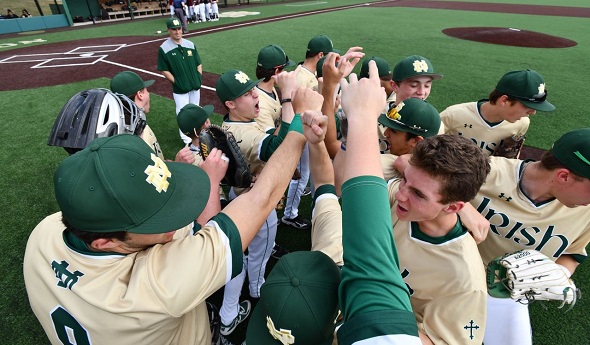
New Coach, New Home, New Success for Irish
By
Tom Markowski
Special for Second Half
May 16, 2018
PONTIAC – Ryan Knutson is shocked by how well he and his teammates at Pontiac Notre Dame Prep played at the start of this season.
 And the hope is that it will carry over to next month’s MHSAA Tournament.
And the hope is that it will carry over to next month’s MHSAA Tournament.
The Irish were 8-22 a year ago and started this spring 16-0. Notre Dame Prep is 21-4 with less than two weeks remaining in the regular season, and the optimism is high that the run won’t end in District play as it has for the past 21 seasons. The Irish have won one District title in the 24 years that the school has been open, in 1996.
Over the past seven seasons, Notre Dame Prep has won a combined six District games.
“The team morale is up, and we bonded as a team,” Knutson said. “I credit the new coaching staff. Going to Florida over spring break helped us bond. It was during that streak – we had some close games – that the team-bonding paid off.”
Jason Gendreau spent 10 seasons as head coach at Utica Eisenhower, with some success. The Eagles won District titles in 2009, 2011 and 2015. The 2015 season also included a 2-1 victory over Birmingham Brother Rice in a Division 1 Regional Semifinal.
Although he’s not looking back, Gendreau, who continues to teach in the Utica school system, said it was not an easy decision to make when he accepted the position at Notre Dame Prep last June.
“(Eisenhower) is loaded with depth,” he said. “Then there’s all the relationships you build over the years. You know what they say. When a coach leaves, 50 percent are pleased, 50 percent are unhappy.”
Pardon Gendreau if he chuckles now and then about the idea of being a coach at Notre Dame Prep. As a child his favorite team was Notre Dame, the one in South Bend. Nothing was better than watching the Irish playing football on a Saturday afternoon.
Add to this another tale of coincidence, or magic, if you will. One of his mentors is Bob Lantzy, the longtime football coach at Eisenhower who recently completed his second season as head football coach at Rochester Hills Stoney Creek. Lantzy was an all-state running back at Harper Woods Notre Dame in the early 1960s and, when Gendreau was hired at the other Notre Dame, Lantzy dusted off his green and gold jersey and hung it on a wall in his house.
For two seasons in the early 2000s Gendreau was an assistant football coach under Lantzy. Something clicked during that brief period and the two have remained good friends over the years.
“Bob and I talk just about every night,” Gendreau said. “He was my mentor (as a coach), but more importantly he’s been my mentor in life.
“You see, I played football at Belding and grew up answering to (then coach) Irv Sigler. There are no more polar opposites than Irv and Bob. Plus, you throw in the west side and how they approach football. The approach is very different. Irv was the ultimate motivator and got in your face. I tried to coach like that when I got to Ike. It didn’t work. Bob molded me.”
Gendreau was well aware he was taking over a program that had experienced limited success, when it was a member of the Detroit Catholic League and now as an independent. That didn’t matter to him. He knew the athletes he was about to coach were well-disciplined. Teach them the fundamentals, let them have some fun (the Florida trip was a first for this group) and maybe they could win a few more games.
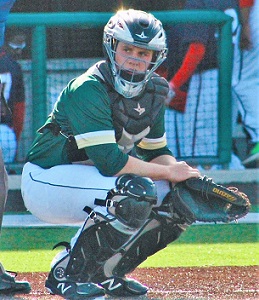 “Lantzy told me opportunity is not time-related,” Gendreau said. “A big thing was, I was able to bring my entire staff over. As far as scheduling, having a lot of relationships with Oakland and Macomb County coaches I was able to schedule competitive schools that were bigger. We played Sterling Heights Stevenson. We played Troy and Troy Athens. We went to Birch Run to play in a tournament with just nine guys because of prom. We made it to the final and lost to Ann Arbor (Gabriel) Richard.
“Lantzy told me opportunity is not time-related,” Gendreau said. “A big thing was, I was able to bring my entire staff over. As far as scheduling, having a lot of relationships with Oakland and Macomb County coaches I was able to schedule competitive schools that were bigger. We played Sterling Heights Stevenson. We played Troy and Troy Athens. We went to Birch Run to play in a tournament with just nine guys because of prom. We made it to the final and lost to Ann Arbor (Gabriel) Richard.
“Plan? I don’t know if we had one, but our goal was to finish .500. We felt comfortable with that. We didn’t want to get beat up. Usually it takes 2-3 years to build a winner. It happened a lot sooner. Part of it is our staff understands our role. We have athletes who are hungry. They’re loyal to one another.”
Notre Dame Prep lost just two seniors last spring to graduation but even so, Knutson said he was surprised by the tremendous start.
He pointed to two factors that keyed the impressive start, and they’re related. One is the defense.
“It’s a main focus,” he said. “Defense is one of the most consistent things of our team. When your defense works, you don’t need as many runs to win. Then on offense you will look to move runners along, trying to get that extra base.”
The second is fundamentals. Knutson said Gendreau and his staff emphasize the finer points of the game: when to bunt, what pitch to look for in certain counts and just an overall awareness of the game.
Even when the offense isn’t producing, defense is a part of the game the Irish can count on. In a weekend series at Lake Orion in late April, Knutson said the team crushed the ball in victories over the host team and Ann Arbor Skyline. The next weekend Notre Dame Prep struggled at the plate and resorted to playing small ball.
The pitching has been consistent as well. River Shea, Jack Kraussman and Jacob Genord have combined for a 17-2 record, and each has an ERA of 2.10 or lower.
There are no superstars on this team. Just two of the eight seniors will go on to play in college. Infielder Brian Blakeslee will attend John Carroll University in Cleveland and play soccer and baseball. Outfielder Tommy Cavanaugh will attend Capital University in Columbus, Ohio, to play baseball.
Knutson, who leads the team in hitting (.448), said he doesn’t plan on playing at the next level and, instead, will attend Michigan State with the intent on majoring in engineering.
“It was hard last year,” he said. “I am so thankful the (new) staff has come in and we’ve been able to make some noise.
“It was that way in football, too. We surprised people by reaching a District Final. It’s kind of similar in baseball. We’re the underdogs. It kind of fueled us.”
***
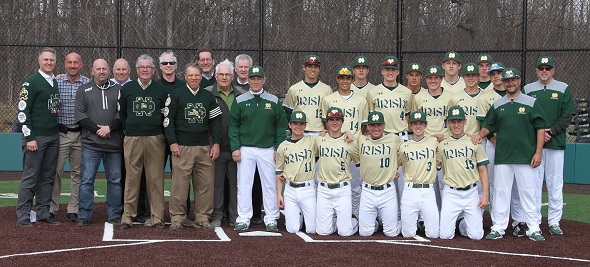
Gendreau said coaching at a large school like Eisenhower has its drawbacks. One is the fact a coach must make cuts. Another is it’s the coach’s responsibility to take care of the field. That takes time.
A bonus for Gendreau was the facilities at Notre Dame Prep. In what is nearly a mirror of what previously was added at Grosse Pointe Woods University Liggett, the field at Notre Dame Prep is all turf. No dirt. Not even in the infield. Gendreau said even the bullpen area is turf.
When one considers the often brutal weather conditions in Michigan, having a turf field at your disposal removes a lot of headaches as far as field preparation, postponements and rescheduling.
“They finished that this past winter,” he said. “When I took the job, I was expecting a grass field.”
 Tom Markowski is a columnist and directs website coverage for the State Champs! Sports Network. He previously covered primarily high school sports for the The Detroit News from 1984-2014, focusing on the Detroit area and contributing to statewide coverage of football and basketball. Contact him at [email protected] with story ideas for Oakland, Macomb and Wayne counties.
Tom Markowski is a columnist and directs website coverage for the State Champs! Sports Network. He previously covered primarily high school sports for the The Detroit News from 1984-2014, focusing on the Detroit area and contributing to statewide coverage of football and basketball. Contact him at [email protected] with story ideas for Oakland, Macomb and Wayne counties.
PHOTOS: (Top) Pontiac Notre Dame Prep players huddle on their new field this season. (Middle) Notre Dame Prep catcher Ryan Knutson looks to his dugout. (Below) The current Irish and 1972-73 alums stand together during the field dedication this spring. (Photos courtesy of the Pontiac Notre Dame Prep baseball program.)
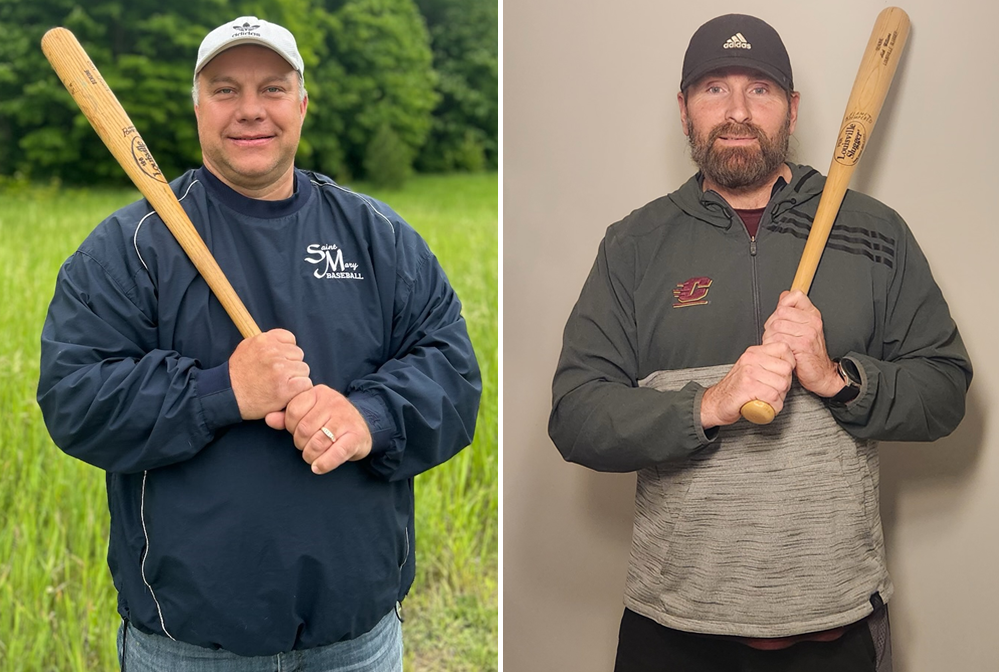
Similarities Tie Slugging Pair's 1991 Pursuit of .600 Average, Paths After
By
Steve Vedder
Special for MHSAA.com
June 11, 2024
They both remember chasing the identical goal 33 years ago.
It wasn't so much that Hastings' Nick Williams and Dwain Koscielniak of Gaylord St. Mary were aware in 1991 of becoming the first MHSAA-recognized .600 hitters in state history. What the two remember most about their magical final high school seasons has little to do with records, but simply closing out outstanding baseball careers with a bang.
"I think it was the same scenario for both of us," Williams said. "You just want to get a hit, drive the ball every time you're up."
It may be forgotten now, but in an era where tracking batting averages wasn't as simple as inserting a thumb drive and a couple clicks on a laptop, it's easy to see how the one-of-a-kind hitting exploits of Williams and Koscielniak may be overlooked. For instance, with just days left in their senior seasons neither knew they were closing in on the state record for batting average of .577 by Greg Atkinson of Maple City Glen Lake in 1985. The two were more focused on helping their teams win District titles and then beginning their summers.
About all the pair really knew was that magical seasons were about to end. Both were batting over .600, but when ballplayers are hitting that well, there's a fine line in maintaining such rare territory. As both found out – one painfully so and the other happily – every at-bat is critical. Koscielniak wound up slugging a pair of homers in his final game to finish with a .629 mark while Williams, who started the last day of his senior season with a hefty .612 mark, went hitless for the first time all spring to finish at 591.
While the chase to hit .600 is obviously an entertaining story, it's only the tip of the iceberg in terms of the amazing parallels between the lives of Koscielniak and Williams, who lived 170 miles apart growing up in Gaylord and Hastings, respectively.
Both, for example, were outstanding dual-sport athletes. Koscielniak graduated second on the Michigan football career rushing list with 5,078 yards from 1987-90, and he still owns the state single-game record of 529 yards against Pellston on Oct. 26, 1990. Williams, meanwhile, averaged 24 points per game as a senior in basketball and could have been a dual-sport athlete at the next level if not for sticking with baseball.
In addition, both went on to stellar collegiate careers. Williams was a second-team all-Mid-American Conference selection in 1995 as a junior, and Central Michigan University captain as a senior. Koscielniak played two years at Mott Community College before becoming a slugging catcher/infielder at Ferris State. He was named Player of the Year in the Great Lakes Intercollegiate Athletic Conference in 1994 when he won the league’s triple crown hitting .403 with nine home runs and 37 RBIs.
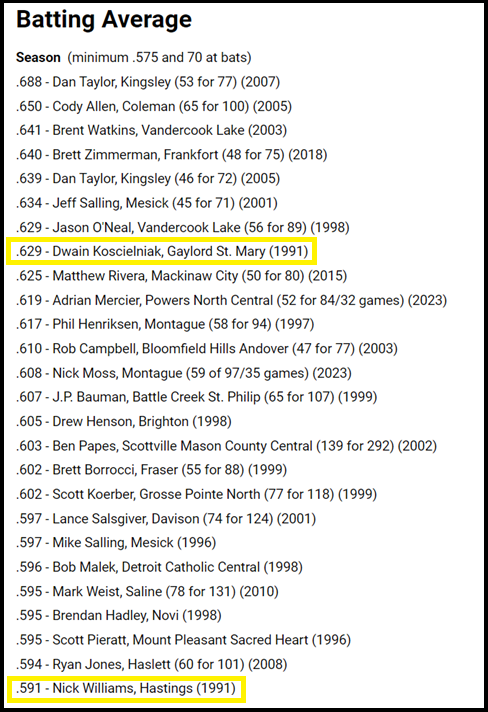 Both had flirtations with pro ball as Williams was taken by the Seattle Mariners in the 48th round of the 1991 MLB draft and later drew interest from Boston and Cincinnati following his time at CMU. Koscielniak was drafted by San Diego in the 32nd round in 1994 and reached High-A a year later. He batted .261 with 32 RBIs in 64 games over two minor league seasons.
Both had flirtations with pro ball as Williams was taken by the Seattle Mariners in the 48th round of the 1991 MLB draft and later drew interest from Boston and Cincinnati following his time at CMU. Koscielniak was drafted by San Diego in the 32nd round in 1994 and reached High-A a year later. He batted .261 with 32 RBIs in 64 games over two minor league seasons.
Koscielniak and Williams, who unknowingly played against each other with their college teams in 1994, also both wound up in athletics after college. Williams became an associate athletic director at Central Michigan, while Koscielniak coached baseball at Gaylord St. Mary.
There's more as both players are fathers of college-level talents. Williams' daughter Jayden ran track at Central Michigan while another daughter, Taryn, is playing volleyball at Delta College. Koscielniak's sons Steven and Christopher both played baseball at Delta College, daughter Brooke is an equestrian at Saginaw Valley State, and youngest son Brett is a three-sport athlete at Gaylord St. Mary.
If there's one more nugget which Williams and Koscielniak have in common, it’s that both credit long hours of work for becoming outstanding hitters. Williams would use a tarp in the family garage for a makeshift hitting cage, while Koscielniak's offseason hitting quarters was a cage stuck away in a pole barn. Both said they would never have approached being .600 hitters without putting in loads of extra time.
"I got my swings in several times a week in the offseason, and that really helped me," said Koscielniak, whose professional career received its earliest spark when a Ferris State science teacher/part-time MLB scout wandered past the school's gymnasium and noticed Koscielniak practicing throws to second base from his spot as catcher during winter workouts.
Williams remembers getting in about 200 at-bats with summer travel teams in Hastings, Grand Rapids and Battle Creek between his junior and senior years.
"I had a lot of success as a hitter because I put the time in," said Williams, who remembers half a dozen scouts at every Saxons game as a senior. "I didn't play a fall sport, and I put in a lot of time just hitting. I became aware of being able to hit the ball the other way, and I think my confidence began to grow."
As for approaching the .600 mark during their final seasons, Williams and Koscielniak said they were blissfully unaware of any state batting records. Williams does recall never considering trying to preserve a .600 average by taking a game off down the stretch.
"No, I never (had) a thought of that – not even a conversation," he said. "A lot of time has passed since then, but I don't remember sitting out at all. No way. I was always going to play, and that's it."
Koscielniak also doesn't recall worrying about hitting 600. While Koscielniak was the first .600 hitter in state history, only 17 others have gone on to become MHSAA-recognized .600 batters. Dan Taylor of Kingsley holds the state record for highest average with a .688 mark in 2007.
Koscielniak also hit 17 home runs as a senior and finished his career with 35, which continues to rank eighth on that statewide all-time list.
"Back then if you loved the game, you just played. How it turned out for me is how it turned out," he said. "I was competitive and played hard. I played well at Mott and then Ferris State, and the door opened up for me a little."
Williams and Koscielniak remember one huge drawback in trying to hit .600: walks. Pitchers would simply not give them anything to hit. Williams remembers a doubleheader against Coldwater where he hit home runs in his first at-bats in both games, then received two intentional walks in both games. Koscielniak's two homers in his final game were followed by two intentional walks.
Such a stingy pitching philosophy was par for the course, they say.
"That becomes very difficult for a hitter," Williams said. "You have to be dialed in when you get your opportunities. It was a fun year for me, but a struggle at times because (the walks) make you feel like you're not doing your job for the team.
"I don't think hitting .600 was a big deal. We didn't talk about stats and those things. You keep track a little, but I had no idea till the end of the year. And in the end, it's not about stats. I loved playing baseball."
These days, Williams is an instructor as part of the physical education and sport faculty at CMU, teaching courses on professional and collegiate athletics. Koscielniak is an operation manager for Schwan’s Food Service and with his wife Liz owns the Gaylord Equestrian Center.
PHOTOS (Top) Dwain Koscielniak, left, and Nick Williams stand for recent photos; they were the state’s top high school hitters in 1991 as both pursued a .600 batting average. (Middle) They continue to rank among the elite on the MHSAA record book list for top batting averages for a single season. (Photos courtesy of Koscielniak and Williams.)

